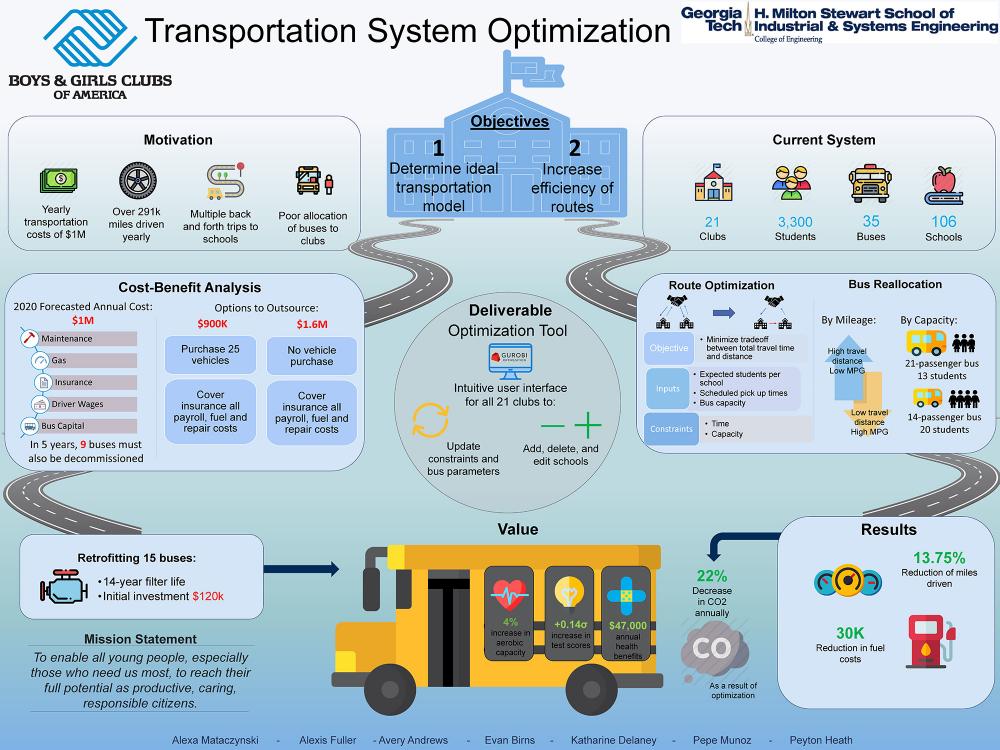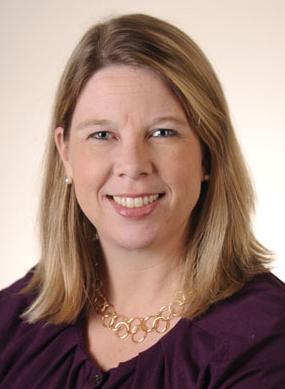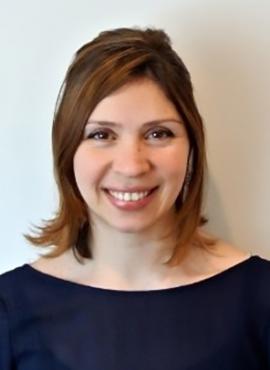Client Context
Boys & Girls Clubs of Metro Atlanta (BGCMA) is a local chapter of the Boys & Girls Clubs of America (BGCA), a national non-profit organization consisting of local chapters that provide after-school and summer programs for disadvantaged youths. BGCMA’s 21 clubs serve over 3,000 students across 108 schools in the metro Atlanta area. To facilitate their programming, BGCMA also offers transportation to their students from schools to the clubs. BGCMA leadership recognizes that excessive time and resources, which could otherwise be used to support their mission of providing opportunities and mentorship for underserved youth, are currently occupied by their transportation system.
Project Objective
The motivation for this project stems from inefficiencies associated with BGCMA’s current transportation system, which costs them over $1 million annually to operate.
The objective of this project is to improve club members’ access to BGCMA’s services in the following ways:
- Determine the ideal transportation model that reduces operating costs while maintaining the quality of club experience provided to students
- Increase the efficiency of routes, finding the ideal trade-off between time in transit and distance traveled
Although BGCMA has considered outsourcing in the past, they have been unable to invest the time to gather quotes and analyze current transportation costs. In 2018, the client spent approximately $125,000 on fleet maintenance and repair. With nearly 60% of the fleet at least 10 years old, the cost of maintain these vehicles will likely increase, occupying resources that could otherwise be used to advance the client’s mission.
The routes in use by BGCMA require buses to travel approximately 290,000 miles per year and, in some cases, return to the same school multiple times each day. Current assignment of buses to clubs also necessitates over-utilization and under-utilization of buses’ capacity and fuel economy.
Design Strategy
To determine the ideal transportation mode, the team conducted a robust analysis of all current operating costs: vehicle maintenance (planned and unplanned), driver salary, insurance, fuel, and bus capital. Based on odometer readings and average miles per year as well as EPA standards, the team also determined that 9 buses must be decommissioned over the next 10 years.
The team then engaged in negotiations with several transportation companies to explore the possibility of outsourcing. After discussions with the client, however, BGCMA executives chose not to pursue this option, citing concerns about selling their vehicles. However the client now has a baseline for outsourcing costs, should they choose to pursue this in the future.
To optimize BGCMA’s transportation system, the team initially created a model that solely minimized distance. After further discussions with the client, the team chose to prioritize the experience of the students over savings in distance. To accomplish this while still increasing the efficiency of the transportation service, the team created a model that optimized the bus routes and schedules for each club. This model considers both time and distance through the use of a multi-objective optimization objective statement implemented through a weighted summation. By creating staggered trips, the model significantly decreases distance while only marginally increasing travel time.
A second set of optimized routes based on a system-wide model has been produced to demonstrate the value of implementing this solution to the client. In this model, buses originally associated with a single club were untied and then reallocated across the system based on student attendance at each club. By better managing attendance, the system-wide approach yielded additional improvements that would not be possible given the current resource distribution.
Deliverables
As part of the cost-benefit analysis, the client has received an analysis of their current operating expenses, including projected future expenses and future vehicle replacement costs. The team also recommended retrofitting vehicles that outdate current EPA emission standards with Diesel Particulate Filters. Finally, the client has been provided with all information associated with outsourcing, including quotes and corresponding contact information. While the client chose not to pursue this, these quotes provide a baseline for future negotiations.
The team provided BGCMA leadership with two sets of optimized routes:
- Maintaining current assignment of vehicles
- Moving buses around system to maximize capacity and fuel economy (this includes where to move buses as well as the routes themselves)
The client has also been provided with an optimization tool that combines both the back-end optimization and the front-end user interface into one package. The back end of the model is run through PULP, an open-source optimization language. The client can then interact with the model through a macro-enabled Excel workbook. This allows them to update parameters associated with the model without any knowledge of optimization or PULP. Extensive user guides have also been provided to ensure proper use of the model by the client.


